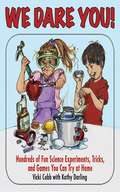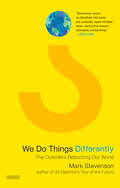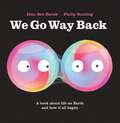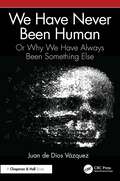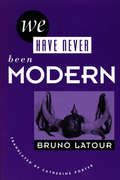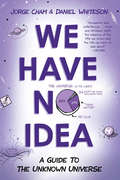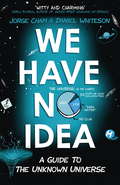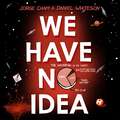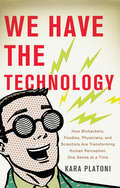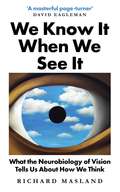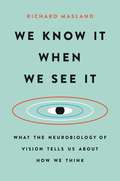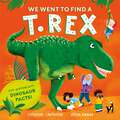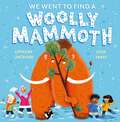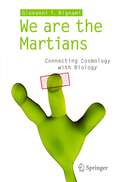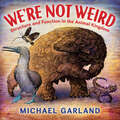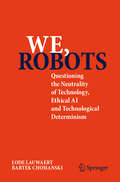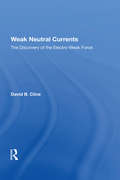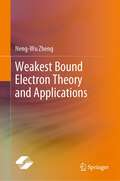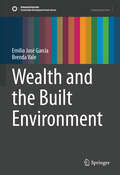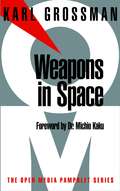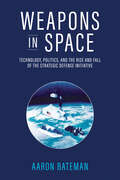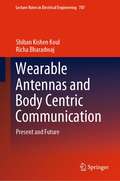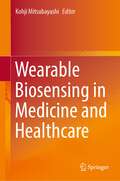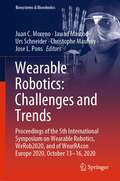- Table View
- List View
We Dare You: Hundreds of Science Bets, Challenges, and Experiments You Can Do at Home
by Vicki Cobb Kathy DarlingWould you believe that you could throw an egg across the room without breaking it? Burn a candle underwater? We Dare You! is a gigantic collection of irresistible, easy-to-perform science experiments, tricks, bets, and games kids can do at home with everyday household objects. Thanks to the principles of gravity, mechanics, fluids, logic, geometry, energy, and perception, kids will find countless hours of fun with the selections included in this book.
We Do Things Differently: The Outsiders Rebooting Our World
by Mark StevensonAn acclaimed futurist visits people around the world who are solving the planet's biggest problems by innovative means. Our systems are failing. Old models—for education, healthcare and government, food production, energy supply—are creaking under the weight of modern challenges. As the world's population heads towards 10 billion, it's clear we need new approaches. In We Do Things Differently, historian and futurologist Mark Stevenson sets out to find them, across four continents. From Brazilian favelas to high tech Boston, from rural India to a shed inventor in England's home counties, Mark Stevenson travels the world to find the advance guard re-imagining our future. At each stop, he meets innovators who have already succeeded in challenging the status quo, pioneering new ways to make our world more sustainable, equitable and humane. Populated by extraordinary characters—including Detroit citizens who created new jobs and promoted healthy eating by building greenhouses, an Austrian mayor who built a new biomass plant using the by-product of a local flooring company, and an Indian doctor who crowdsourced his research and published his findings online—We Do Things Differently paints a riveting picture of what can be done to address the world’s most pressing dilemmas, offering a much needed dose of down-to-earth optimism. It is a window on (and a roadmap to) a different and better future.
We Go Way Back: A Book About Life on Earth and How it All Began
by Idan Ben-BarakFrom the author of kid-favorite Do Not Lick This Book comes an innovative, hilarious, and expansive picture book about the biggest question of all: What is life?It's not an easy question.Life is more than just one thing.Where did it start?Peer back in time - way back in time - to the story of how life began…
We Have Never Been Human: Or Why We Have Always Been Something Else
by Juan de Dios VázquezWe Have Never Been Human: Or Why We Have Always Been Something Else boldly reimagines what it means to be human, challenging the traditional notions that bind our identity to biology and culture. From ancient mythologies to modern technologies, this book reveals a dynamic, ever-evolving human identity shaped by external forces and technological advancements.Blending insights from philosophy, technology studies, anthropology, and cultural critique, We Have Never Been Human: Or Why We Have Been Something Else offers an interdisciplinary exploration of our constructed identities and what they portend for the future of society. It raises essential questions: How has technology reshaped our self-perception? Are humans fixed beings, or are we endlessly evolving? What ethical, social, and political challenges arise as we integrate with intelligent machines?This book is a compelling read for those intrigued by the intersection of humanity and technology, offering profound insights into the essence of what it means to be human—or perhaps, what it means to evolve beyond the human.
We Have Never Been Modern
by Bruno LatourWith the rise of science, we moderns believe, the world changed irrevocably, separating us forever from our primitive, premodern ancestors. But if we were to let go of this fond conviction, Bruno Latour asks, what would the world look like? His book, an anthropology of science, shows us how much of modernity is actually a matter of faith. What does it mean to be modern? What difference does the scientific method make? The difference, Latour explains, is in our careful distinctions between nature and society, between human and thing, distinctions that our benighted ancestors, in their world of alchemy, astrology, and phrenology, never made. But alongside this purifying practice that defines modernity, there exists another seemingly contrary one: the construction of systems that mix politics, science, technology, and nature. The ozone debate is such a hybrid, in Latour's analysis, as are global warming, deforestation, even the idea of black holes. As these hybrids proliferate, the prospect of keeping nature and culture in their separate mental chambers becomes overwhelming--and rather than try, Latour suggests, we should rethink our distinctions, rethink the definition and constitution of modernity itself. His book offers a new explanation of science that finally recognizes the connections between nature and culture--and so, between our culture and others, past and present. Nothing short of a reworking of our mental landscape. We Have Never Been Modern blurs the boundaries among science, the humanities, and the social sciences to enhance understanding on all sides. A summation of the work of one of the most influential and provocative interpreters of science, it aims at saving what is good and valuable in modernity and replacing the rest with a broader, fairer, and finer sense of possibility.
We Have No Idea: A Guide to the Unknown Universe
by Daniel Whiteson Jorge ChamPrepare to learn everything we still don’t know about our strange, mostly mysterious universe. <P><P>PHD Comics creator Jorge Cham and particle physicist Daniel Whiteson have teamed up to spelunk through the enormous gaps in our cosmological knowledge, armed with their popular infographics, cartoons, and unusually entertaining and lucid explanations of science. <P><P> In We Have No Idea, they explore the biggest unknowns in the universe, why these things are still mysteries, and what a lot of smart people are doing to figure out the answers (or at least ask the right questions). <P><P>While they're at it, they helpfully demystify many complicated things we do know about, from quarks and neutrinos to gravitational waves and exploding black holes. <P><P>With equal doses of humor and delight, they invite us to see the universe as a vast expanse of mostly uncharted territory that's still ours to explore. <P><P>This entertaining illustrated science primer is the perfect book for anyone who's curious about all the big questions physicists are still trying to answer.
We Have No Idea: A Guide to the Unknown Universe
by Daniel Whiteson Jorge Cham'This witty book reveals the humbling vastness of our ignorance about the universe, along with charming insights into what we actually do understand' Carlo Rovelli, author of Seven Brief Lessons on Physics and Reality Is Not What It SeemsIn our small corner of the universe, we know how some matter behaves most of the time and what even less of it looks like, and we have some good guesses about where it all came from. But we really have no clue what's going on. In fact, we don't know what about 95% of the universe is made of. So what happens when a cartoonist and a physicist walk into this strange, mostly unknown universe? Jorge Cham and Daniel Whiteson gleefully explore the biggest unknowns, why these things are still mysteries, and what a lot of smart people are doing to figure out the answers (or at least ask the right questions). While they're at it, they helpfully demystify many complicated things we do know about, from quarks and neutrinos to gravitational waves and exploding black holes. With equal doses of humour and delight, they invite us to see the universe as a vast expanse of mostly uncharted territory that's still ours to explore. This is a book for fans of Brian Cox and What If. This highly entertaining highly illustrated book is perfect for anyone who's curious about all the great mysteries physicists are going to solve next.
We Have No Idea: A Guide to the Unknown Universe
by Daniel Whiteson Jorge Cham'This witty book reveals the humbling vastness of our ignorance about the universe, along with charming insights into what we actually do understand' Carlo Rovelli, author of Seven Brief Lessons on Physics and Reality Is Not What It SeemsMany books explain what we know about the universe. This one, from the hugely popular PhD Comics (50 million readers since 2008), tackles all the weird stuff we haven't figured out yet.In our small corner of the universe, we know how some matter behaves most of the time and what even less of it looks like, and we have some good guesses about where it all came from. But we really have no clue what's going on. In fact, we don't know what about 95% of the universe is made of. So what happens when a cartoonist and a physicist walk into this strange, mostly unknown universe? Jorge Cham and Daniel Whiteson gleefully explore the biggest unknowns, why these things are still mysteries, and what a lot of smart people are doing to figure out the answers (or at least ask the right questions). While they're at it, they helpfully demystify many complicated things we do know about, from quarks and neutrinos to gravitational waves and exploding black holes. With equal doses of humour and delight, they invite us to see the universe as a vast expanse of mostly uncharted territory that's still ours to explore. This is a book for fans of Brian Cox and What If. This highly entertaining highly illustrated book is perfect for anyone who's curious about all the great mysteries physicists are going to solve next.(P)2017 Penguin Random House Audio
We Have The Technology: How Biohackers, Foodies, Physicians, And Scientists Are Transforming Human Perception, One Sense At A Time
by Kara PlatoniAn award-winning journalist investigates how scientists and citizens around the world are re-tooling our senses--and what their discoveries are teaching us about the nature and future of human perception
We Know It When We See It: What the Neurobiology of Vision Tells Us About How We Think
by Richard MaslandSpotting a face in a crowd is so easy, you take it for granted. But how you do it is one of science's great mysteries. Vision is involved in nearly a third of everything a brain does and explaining how it works reveals more than just how we see. It also tells us how the brain processes information – how it perceives, learns and remembers. In We Know It When We See It, pioneering neuroscientist Richard Masland covers everything from what happens when light hits your retina, to the increasingly sophisticated nerve nets that turn that light into knowledge, to what a computer algorithm must be able to do before it can truly be called &‘intelligent&’. It is a profound yet accessible investigation into how our bodies make sense of the world.
We Know It When We See It: What the Neurobiology of Vision Tells Us About How We Think
by Richard Maslandp.p1 {margin: 0.0px 0.0px 0.0px 0.0px; font: 13.3px Times} A Harvard researcher investigates the human eye in this insightful account of what vision reveals about intelligence, learning, and the greatest mysteries of neuroscience.Spotting a face in a crowd is so easy, you take it for granted. But how you do it is one of science's great mysteries. And vision is involved with so much of everything your brain does. Explaining how it works reveals more than just how you see. In We Know It When We See It, Harvard neuroscientist Richard Masland tackles vital questions about how the brain processes information -- how it perceives, learns, and remembers -- through a careful study of the inner life of the eye. Covering everything from what happens when light hits your retina, to the increasingly sophisticated nerve nets that turn that light into knowledge, to what a computer algorithm must be able to do before it can be called truly "intelligent," We Know It When We See It is a profound yet approachable investigation into how our bodies make sense of the world.
We Went to Find a T. Rex (We Went to Find... #1)
by Catherine CawthorneWe went to find a T. rex . . . and it was NOWHERE to be found.It wasn't hiding in the ferns. Or swimming in the river. And it DEFINITELY wasn't flying high in the sky.Everywhere we looked, we found other dinosaurs instead. There was a towering triceratops with its pointy beak and fancy grills. A super huge stegosaurus that was having an afternoon snooze. And a scary spinosaurus that we had to swim past VERY carefully as it ate a pile of fish for lunch. But absolutely NO sign of a T. rex.Where could such a HUGE great dinosaur be hiding?Meet some of the incredible and unbelievably large dinosaurs in this laugh-out-loud picture book story that features hilarious, fascinating and slightly bizarre facts throughout. Perfect for fans of We're Going on a Bear Hunt.
We Went to Find a Woolly Mammoth (We Went to Find... #1)
by Catherine CawthorneWe went to find a woolly mammoth ... and it was NOWHERE to be found.It wasn't chilling on the snow-covered lands. Or swimming in the icy river. And it DEFINITELY wasn't hiding in the frozen forest. Everywhere we looked, we found strange creatures instead. There was a hairy scary woolly rhino rolling around in some grass (weird ... we thought it always snowed in the Ice Age). A spotty dotty sabre-tooth cat that was ready for a fight (RUN!) And a spiky feisty giant armadillo (but I crept right past him - armadillos are pretty blind you know ...). But absolutely NO mammoths.Where could such a HUGE great MAMMOOSIVE creature be hiding?Meet some of the incredible and unbelievably large creatures from the Ice Age in this laugh-out-loud picture book story that features hilarious, fascinating and slightly bizarre facts throughout. Perfect for fans of We're Going on a Bear Hunt.
We are the Martians
by Giovanni F BignamiFor many thousands of years, human beings have been asking themselves whether they are more frightened of being alone in the universe or of the thought that there is someone else out there. Over the past few decades, however, we have moved from imagination to action, exploring the cosmos using new techniques, often with surprising results. Numerous fascinating but little known facts have emerged - for example, that every year many rocks from Mars fall on the Earth, that one of our amino acids has been found in the coma of a comet, and that some of the known thousands of extrasolar planets are similar to our own. There are further exciting and important discoveries around the corner that will cast more light on the great enigma of how life started on Earth. In this intriguing book, one of the World's leading researchers in astrophysics and space science examines fundamental questions concerning life on Earth and the rest of the cosmos in an accessible and stimulating way.
We're Not Weird: Structure and Function in the Animal Kingdom
by Michael GarlandMeet nature&’s most extraordinary looking creatures. But they aren&’t weird!Birds with blue feet, fish that walk, unicorns in the sea, and more! Learn how these animals' quirks help them survive. Perfect for budding naturalists who are always ready to share a cool (or gross) animal fact. Very hard scales protect me, and my long tongue is perfect for eating ants. When I feel threatened, I roll myself into a ball. I am a Pangolin.See these animals&’ amazing body parts in vibrant and detailed woodcut illustrations, from the thorny dragon&’s spiky skin to the star-nosed mole's twenty-two feelers. Read how these creatures' unique traits help them thrive and survive in their environments. Learn where they live, what they eat, how they protect themselves, and more. With easy-to-read text vetted by an expert, this book aligns with the Next Generation Science Standards on adaptation, structure, and function for kindergarten through 3rd grade. With supplementary information on each animal&’s habitat and diet.
We, robots: Questioning the Neutrality of Technology, Ethical AI and Technological Determinism
by Lode Lauwaert Bartek ChomanskiThis book takes a philosophical look at traditional technological tools such as hammers and drills as well as the modern: autonomous cars, ChatGPT, smartphones, apps, steam engines, nuclear power plants, computers, and many other systems that surround us. The three main questions tackled are: Is technology neutral? Or is the design often intertwined with a Western or gendered perspective? What are the ethical risks of AI? Is it necessarily biased? Is the climate problem linked to smart technologies? Is technological determinism correct? In other words, is the world controlled by engineers since the digital revolution, or are their inventions merely a product of society? Lode Lauwaert and Bartek Chomanski offer an idiosyncratic perspective on technology and AI. The result is a nuanced and critical view of the key themes of our time. This book appeals broadly to students, researchers as well as non-academic audiences for an introduction to the philosophy of technology and AI. “This book explores key themes that all revolve around the idea that technology is not neutral. This is a message for all of us. Because technology is us.” Mark Coeckelbergh, University of Vienna
Weak Neutral Currents: The Discovery Of The Electro-Weak Force (Frontiers in Physics #97)
by David ClineThis book attempts to trace the key experimental developments that led to the discovery of weak neutral currents in 1973 and the W, Z bosons in 1983, all of the results of which culminated in the identification of the unified-electroweak force.
Weakest Bound Electron Theory and Applications
by Neng-Wu ZhengThis monograph describes the new quantum theory called the weakest bound electron theory (WBE theory) proposed by Prof. Neng-Wu Zheng and its applications. It starts with the fundamentals of quantum mechanics and then illustrates the key points of WBE theory and the mathematical expressions of WBE theory. Finally, it presents a wide range of applications of WBE theory to the chemical and physical properties of atoms and molecules, including energy levels, transition properties, the difference law of ionization energies etc. It appeals to a broad readership, particularly researchers and academics in chemistry, physics, and materials science.
Wealth and the Built Environment (Sustainable Development Goals Series)
by Brenda Vale Emilio José GarcíaThe need to address global environmental problems is urgent. The United Nations 17 Sustainable Development Goals (SDGs) cover a wide range of global concerns, from poverty, hunger, and gender equity to justice and climate action. Concerningly, the SDGs still have faith in economic growth and technological innovation as the means of fixing all global concerns, including climate change. What is not questioned is whether solving development and sustainability problems through economic growth for the accumulation of wealth for the few has led to many of the current unequal development and environmental problems. If unfair growth and wealth accumulation have been part of the problem, how can they be part of the solution? The problem with the SDGs is that their fulfilment relies on wealth creation without the fundamental concomitant of wealth redistribution. The one common driver of change affecting both sustainability and development that has not been included in the SDGs is wealth, the central focus of this book. SDG 11 – sustainable cities and communities – presents a further paradox unless the issue of wealth and its fair distribution is grasped. Cities are the places where wealth is generated but are also places where only a minority are wealthy. The wealth generated in cities leads to higher consumption of resources, higher emissions, and higher disparities and inequalities. However, any version of a sustainable future will happen in the built environment made according to current ideals, like the present belief in overcoming all humanity's problems by becoming wealthier. A fundamental assumption of this book is that the first step toward a fairer habitat that can maintained with the resources available is only possible if we stop designing cities and buildings as if everyone were wealthy or had to become wealthy. To achieve this goal, it is essential to identify and raise awareness of the impact of wealth, to question how the myths about the advantages of wealth were built, where they come from, what shape they take in the built environment and who benefits from them.
Weapons in Space (Open Media Series)
by Michio Kaku Karl GrossmanWeapons in Space examines how the United States is forcing forward--in violation of international treaties--to militarize space. Based on excerpts from U.S. government documents, award-winning investigative journalist Karl Grossman outlines the U.S. military's space doctrine, its similarity with the original Stars Wars scheme of Ronald Reagan and Edward Teller, and the space-based lasers, hypervelocity guns, and particle beams it plans to deploy in its mission to "dominate" earth.Grossman shows the intimate link between the militarization and the nuclearization of space, and follows the flow of billions of U.S. tax dollars to the corporations that research and develop weapons for space. His book explains the Outer Space Treaty and gives a history of the Global Network Against Weapons and Nuclear power in Space: what it is doing, what it plans to do--and what the reader can do to challenge U.S. plans to turn the heavens into a war zone.
Weapons in Space: Technology, Politics, and the Rise and Fall of the Strategic Defense Initiative
by Aaron BatemanA new and provocative take on the formerly classified history of accelerating superpower military competition in space in the late Cold War and beyond.In March 1983, President Ronald Reagan shocked the world when he established the Strategic Defense Initiative (SDI), derisively known as &“Star Wars,&” a space-based missile defense program that aimed to protect the US from nuclear attack. In Weapons in Space, Aaron Bateman draws from recently declassified American, European, and Soviet documents to give an insightful account of SDI, situating it within a new phase in the militarization of space after the superpower détente fell apart in the 1970s. In doing so, Bateman reveals the largely secret role of military space technologies in late–Cold War US defense strategy and foreign relations.In contrast to existing narratives, Weapons in Space shows how tension over the role of military space technologies in American statecraft was a central source of SDI&’s controversy, even more so than questions of technical feasibility. By detailing the participation of Western European countries in SDI research and development, Bateman reframes space militarization in the 1970s and 1980s as an international phenomenon. He further reveals that even though SDI did not come to fruition, it obstructed diplomatic efforts to create new arms control limits in space. Consequently, Weapons in Space carries the legacy of SDI into the post–Cold War era and shows how this controversial program continues to shape the global discourse about instability in space—and the growing anxieties about a twenty-first-century space arms race.
Wearable Antennas and Body Centric Communication: Present and Future (Lecture Notes in Electrical Engineering #787)
by Shiban Kishen Koul Richa BharadwajThis book presents state-of-the-art technologies, trends and applications with a focus on the healthcare domain for ultra-wideband (3.1–10.6 GHz) and 60 GHz (57–66 GHz) wireless communication systems. Due to various key features such as miniaturized antenna design, low power, high data rate, less effects on the human body, relatively less crowded spectrum, these technologies are becoming popular in various fields of biomedical applications and day-to-day life. The book highlights various aspects of these technologies related to body-centric communication, including antenna design requirements, channel modeling and characterization for WBANs, current fabrication and antenna design strategies for textile, flexible and implanted antennas. Apart from the general requirements and study related to these frequency bands, various application specific topics such as localization and tracking, physical activity recognition and assessment, vital sign monitoring and medical imaging are covered in detail. The book concludes with the glimpses of future aspects of the UWB and 60 GHz technology which includes IoT for healthcare and smart living, novel antenna materials and application of machine learning algorithms for overall performance enhancement.
Wearable Biosensing in Medicine and Healthcare
by Kohji MitsubayashiThis book contains chapters on wearable biomedical sensors and their assistive technologies for promoting behavioral change in medical and health care. Part I reviews several wearable biomedical sensors based on biocompatible materials and nano and micro-electromechanical systems (MEMS) technologies in the medical and dental fields. Part II introduces the latest approaches to wearable biosensing using unique devices for various skin targets such as sweat, interstitial fluid, and transcutaneous gases. Part III presents technologies supporting wearable sensors, including soft and flexible materials, manufacturing methods, skin volatile-marker imaging, and energy harvesting devices.This book is intended for graduate students, academic researchers, and professors that work in medical and healthcare research fields, as well as industry professionals involved in the development of wearable and flexible sensing devices and measurement systems for human bio/chemical sensing, medical monitoring, and healthcare services, and for medical professionals and government officials who are driving behavior change in health care.
Wearable Robotics: Proceedings of the 5th International Symposium on Wearable Robotics, WeRob2020, and of WearRAcon Europe 2020, October 13–16, 2020 (Biosystems & Biorobotics #27)
by Juan C. Moreno Jawad Masood Urs Schneider Christophe Maufroy Jose L. PonsThis book reports on advanced topics in the areas of wearable robotics research and practice. It focuses on new technologies, including neural interfaces, soft wearable robots, sensors and actuators technologies, discussing industrially and medically-relevant issues, as well as legal and ethical aspects. It covers exemplary case studies highlighting challenges related to the implementation of wearable robots for different purposes, and describing advanced solutions. Based on the 5th International Symposium on Wearable Robotics, WeRob2020, and on WearRacon Europe 2020, which were both held online on October 13-16, 2020, the book addresses a large audience of academics and professionals working in for the government, in the industry, and in medical centers, as well as end-users alike. By merging together engineering, medical, ethical and industrial perspectives, it offers a multidisciplinary, timely snapshot of the field of wearable technologies.
